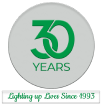Age Related macular degeneration (ARMD)
ARMD is a degenerative disease of the macula which is the main part of the retina. The macula is responsible for our central vision and helps us to read write, recognize faces and do all fine work. This disease is more common in older people. It is the most common cause of vision loss among people 50 years and older in the western world. It usually affects both eyes though one eye may be affected much before the other. The second eye gets involved in over 60% of cases within 5 years.
What are the types of ARMD?
ARMD is of two types (dry and wet). Dry ARMD is the more common (90% of patients) and less devastating form whereas Wet ARMD is less common (10% of patients) but can cause rapid, severe loss of central vision.
What is ‘Dry ARMD’?
Dry ARMD is characterized by drusen, which appear as small yellow deposits underneath the retina. It is usually associated with mild visual loss. Sometimes there can be severe vision loss in Dry ARMD if retinal atrophy (called geographic atrophy) develops.
What are the Symptoms of dry ARMD?
There may be a progressive, steady decline of central vision such as difficulty in reading or recognizing faces, distortion of straight lines, seeing things smaller or bigger than they are. Getting around the house is not affected as the peripheral vision spared.
How is Dry ARMD treated?
There is no treatment for Dry ARMD though there is some evidence that antioxidant vitamin preparations, minerals, Co-enzyme Q, epigallocatechin, lutein, Zeaxanthine, Omega 3 fatty acids, may decrease the occurrence of wet ARMD. However roughly 10% (one in ten individuals) with Dry ARMD may progress to Wet ARMD and it is important to monitor people with Dry AMD to pick up this transition AT THE EARLIEST.
How does one monitor Dry ARMD?
The best way to monitor Dry ARMD to pick up early signs of conversion to Wet ARMD is to perform an ‘Amsler Charting’ at weekly intervals. The test must be performed one eye at a time with reading glasses. Any distortions in the grid should be reported to the doctor immediately and could mean a conversion to Wet ARMD. Doing the chart helps to catch this at the earliest.
What is ‘Wet ARMD’?
Wet AMD is characterized by the growth of abnormal new blood vessels underneath the macula called choroidal neovascular membranes (CNVM). If untreated the membrane destroys the macula resulting in a scar.
What are the symptoms of Wet ARMD?
The main symptoms of neovascular AMD are sudden deterioration in central vision, blind spots, and distortion of vision. Eventually there is a complete loss of central vision.
How is it diagnosed?
Definitive diagnosis and classification of the type of Wet ARMD requires specialized tests namely Fundus Fluorescein angiography (FFA) and Optical Coherence Tomography (OCT).
How is Wet ARMD treated?
Treatment is directed at arresting the neovascular membrane at the earliest. The various modalities used are given below.
Injections of medicines (‘Anti-VEGFs)’ in the eye
The most commonly used treatment for wet ARMD is the injection of anti-VEGF drugs in the eye. The drugs that may be used are Pegaptanib sodium (Macugen), Ranibizumab (Lucentis) and Bevacizumab( Avastin). They may need to be injected repeatedly. Very often a loading dose of three injections at monthly intervals is given followed by injections as and when required.
Photodynamic therapy (PDT) with verteporfin (visudyne)
The principle of treatment is to destroy the neovascular membrane without damaging the overlying retina. It involves intravenous injection of a dye called verteporfin (visudyne) which specifically gets concentrated in the membrane. The membrane is then treated with a special laser which activates the dye and only destroys the membrane sparing the overlying retina.
Combination therapy: PDT and anti-VEGF
There are ongoing trials assessing this treatment option. Results are promising so far, suggesting improved efficacy, reduced frequency of re-treatments and reduced toxicity. However, there is as yet insufficient evidence available to recommend this line of treatment as routine.
Laser photocoagulation
It is suitable for the treatment of membranes that are situated away from the fovea (the most central area of the macula).
What are the preventive measures?
Most preventive measures focus around dietary issues. Antioxidants Vitamin C, Vitamin E, Omega 3 fatty acids, Lutein, Zeaxanthine, Co-enzyme Q 10, Trans-resveratrol, Epigallocatechin gallate (ECGC) have been studied as potentially protective.
Also giving up ‘smoking’ is an important preventive measure.
How are patients with advanced ARMD rehabilitated?
Rehabilitation of patients with advanced ARMD revolves around maximising any remaining visual function and assisting the person to maintain an independent life for as long as possible. It may involve:
Refraction (i.e. glasses check by the optician) – to make sure that any remaining vision is the best it can be.
Low visual aids clinic referral which will provide practical training and coping strategies and help with certain tools such as-Magnifiers for near vision, telescopes for distance vision, large print books, talking tapes, variety of gadgets to help with household tasks.
Counseling to reassure them that they will not go totally blind as peripheral vision is preserved.








